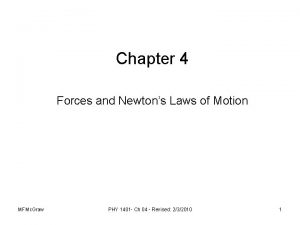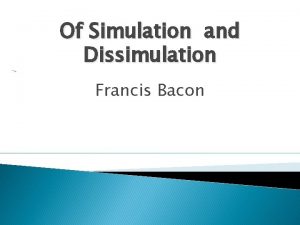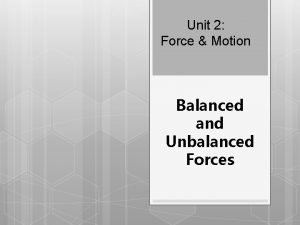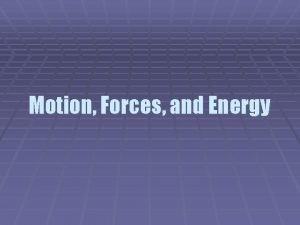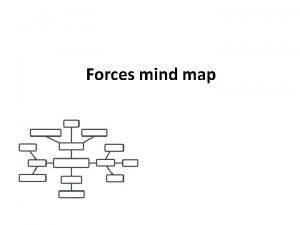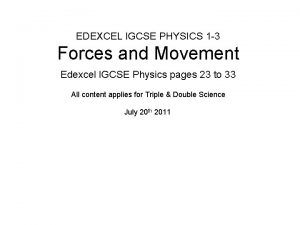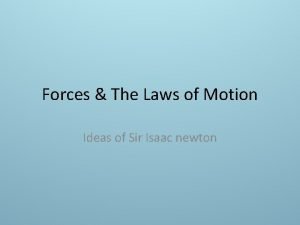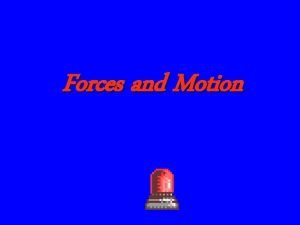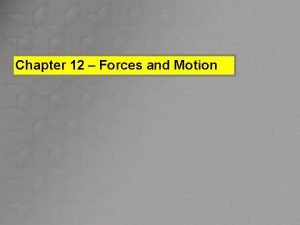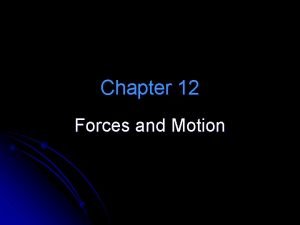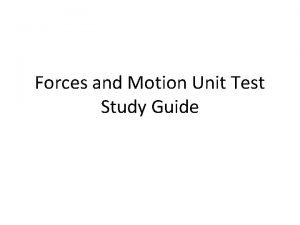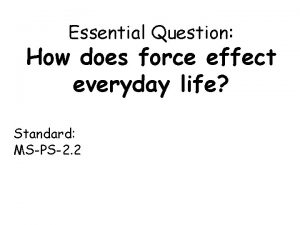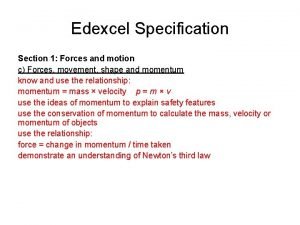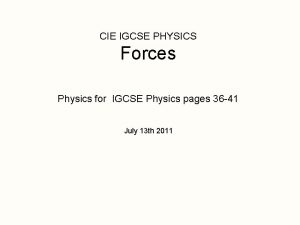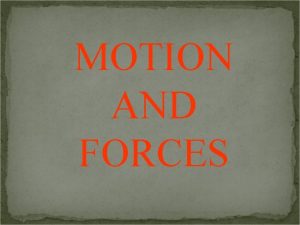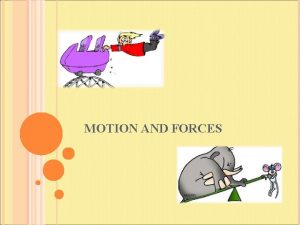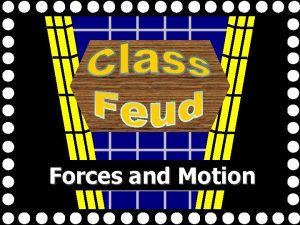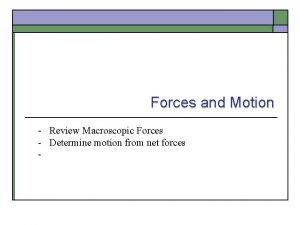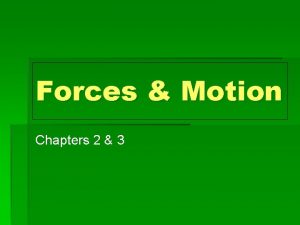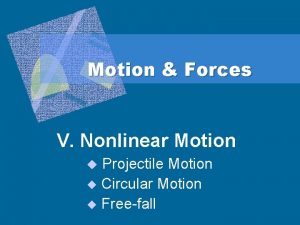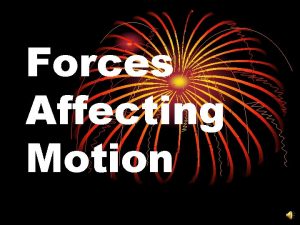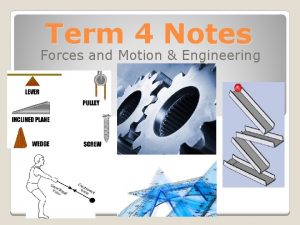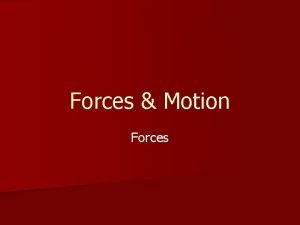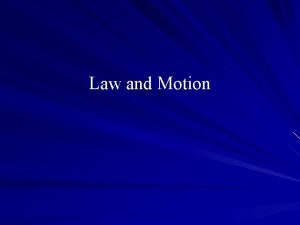Forces and Motion Simulation Summary Notes Forces Forces






















- Slides: 22

Forces and Motion Simulation Summary Notes

Forces

Forces �Forces have Magnitude and Direction. 50 N in Each direction �We represent these in diagrams with arrows. �Larger the force the bigger the arrow.

Forces and Motion �When we look at a diagram we can figure out the sum of forces. 50 N in each Direction �Sum of forces = Force applied- friction force. �In other words = Larger force – smaller force.

Forces �If 50 N in each direction the forces are equal then the sum of forces will be 0. The object won’t move. �This is a equal force

Forces � Sum 150 N of forces= Force applied – friction force � What is friction? � Friction- is the force resisting the relative motion of solid surfaces, fluid layers, and material elements sliding against each other � Which one is resisting movement?

Forces � The 150 N force to the right is bigger then the force to the left. � The object will move to the left. The right force is resisting movement. � Sum of forces- 150 N 50 N=100 N to the left. � This is a Unequal force

Motion

Motion � Important to consider!! � In this simulation FRICTION was NOT taken into consideration. � No friction was acting on the wheels of the skate board

Motion � The heavier the mass of the object the longer it took for the object to reach maximum speed. � Mass- a property of a physical body which determines the strength of its mutual gravitational attraction to other bodies and its resistance to being accelerated by a force.

Friction

Friction �is the force resisting the relative motion of solid surfaces, fluid layers, and material elements sliding against each other. �There are four kinds of friction we are going to talk about. Static Friction, Sliding Friction, Rolling Friction, and Fluid Friction.

Static Friction � Static Friction – occurs when a body is forced to move along a surface but movement does not start. � The magnitude of the friction force is equal or greater than the applied force. No movement occurs.

Sliding (kinetic) Friction �This occurs when the applied force is greater then the frictional force. �This causes the object to move along the surface.

Rolling Friction. � This is what was being ignored in the motion simulation. � Rolling friction is a force that slows down the motion of a rolling object. � Combination of frictional forces at the point of contact with the wheel and the ground/surface.

Fluid friction � Occurs when a body moves in a fluid or air and there exist a resistive force that slows down the motion. � Freely falling skydiver feels a drag force due to air which acts in the upward direction (opposite) of the skydivers motion.

Acceleration

Acceleration � Acceleration - defined as the rate at which an object changes its velocity (speed+direction). An object is accelerating if it is changing its velocity. � Velocity- is simply speed+ direction.

Acceleration � Math makes this easier to understand � Acceleration = Force (N) / Mass(kg) � Acceleration has the units of meters per second squared (m/s 2 )

Newton's Laws of Motion � 1 st Law- Every object in a state of uniform motion tends to remain in that state of motion unless an external force is applied to it.

Newton's Laws � 2 nd -The relationship between an object's mass m, its acceleration a, and the applied force F is F = ma. Acceleration and force are vectors

Newton's 3 rd law � For every action there is an equal and opposite reaction.
 Normal force
Normal force Simulation of hair appearance and motion download
Simulation of hair appearance and motion download Of simulation and dissimulation by francis bacon summary
Of simulation and dissimulation by francis bacon summary Francis bacon essay of simulation and dissimulation
Francis bacon essay of simulation and dissimulation Active rom
Active rom Facteur g
Facteur g Balanced and unbalanced forces examples
Balanced and unbalanced forces examples Motion forces and energy
Motion forces and energy Forces and motion mind map
Forces and motion mind map Edexcel igcse physics movement and position questions
Edexcel igcse physics movement and position questions Section 3 motion and forces worksheet answers
Section 3 motion and forces worksheet answers Derek leaves his physics book on top of a drafting table
Derek leaves his physics book on top of a drafting table Force and motion jeopardy
Force and motion jeopardy Laws of motion
Laws of motion Chapter 12 forces and motion
Chapter 12 forces and motion Chapter 9 motion and energy answer key
Chapter 9 motion and energy answer key Force and motion unit test
Force and motion unit test Study jams force and motion
Study jams force and motion Mass x velocity
Mass x velocity Igcse
Igcse Unbalanced forces
Unbalanced forces Waves 2 physics notes
Waves 2 physics notes Section 1 describing motion
Section 1 describing motion
